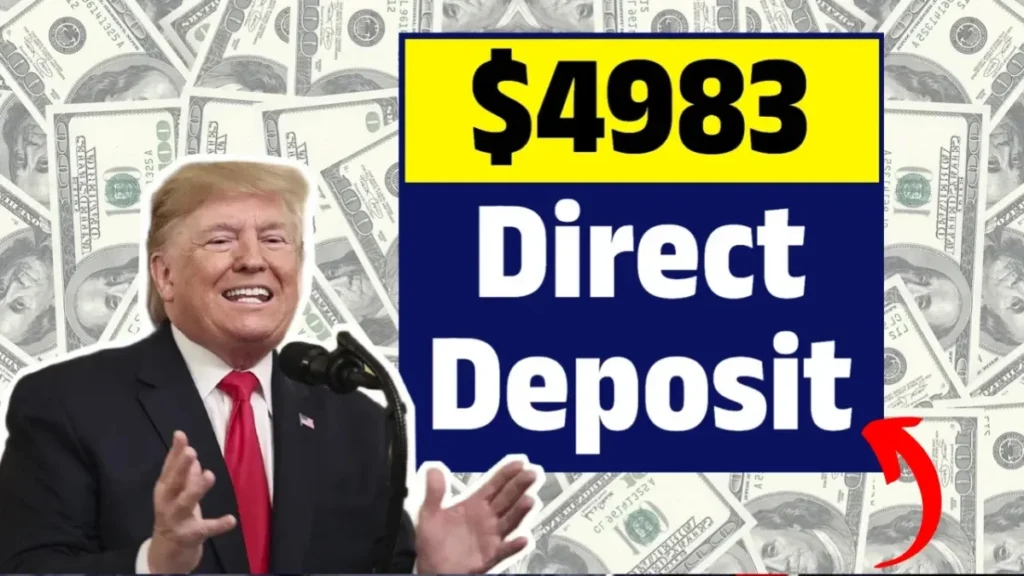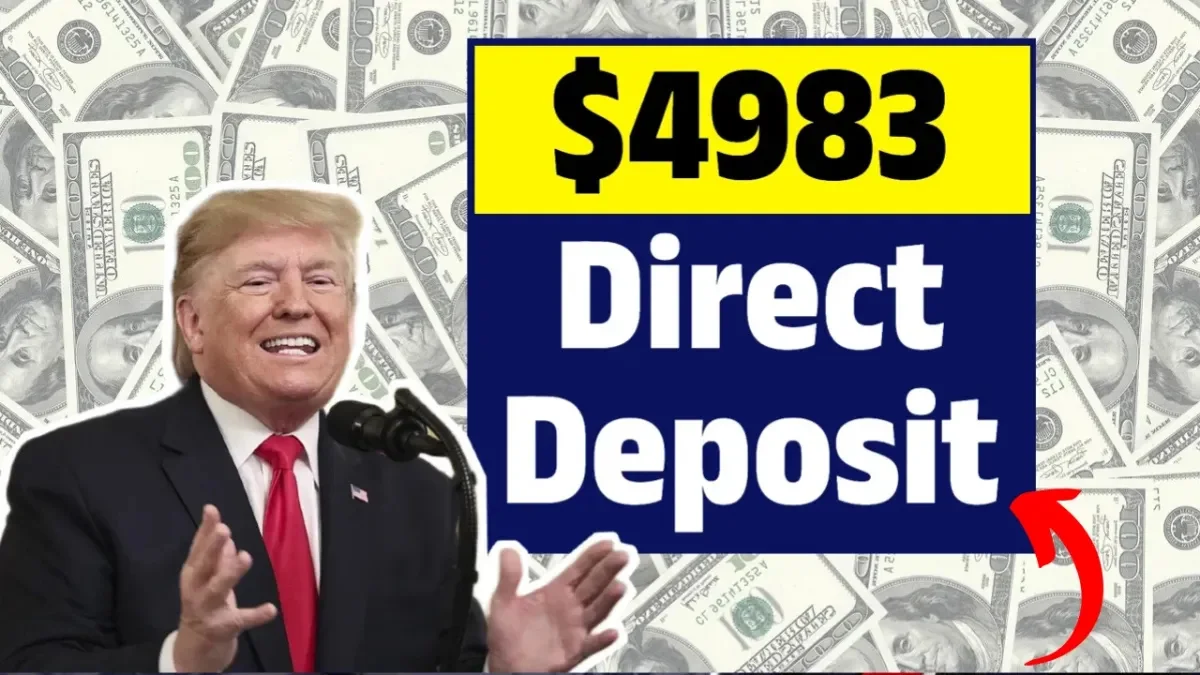As financial uncertainty continues into late 2025, reports of a $4,983 direct deposit have caught the attention of millions of Americans. This potential one-time payment — expected to be distributed on October 27, 2025 — is being discussed as part of a targeted federal financial relief initiative designed to help citizens facing persistent inflation and rising costs of living. Although not yet fully confirmed by the U.S. Department of the Treasury, preliminary details from budget discussions and IRS channels indicate that this payment could go to eligible Americans under specific income and tax conditions.
The initiative, unofficially referred to as the 2025 Federal Cost-of-Living Relief Program, aims to assist low- and middle-income families, retirees, and workers affected by elevated housing, healthcare, and food costs. If approved, it would mark one of the largest individual direct-deposit amounts in recent federal relief history.
Also Read : Yellowstone Season 7 Trailer 2026: Release Date, Cast, and Every Latest Detail Fans Need to Know

Why the $4,983 Direct Deposit Is Being Considered
The U.S. economy has shown uneven recovery across 2025. While employment remains strong, core inflation continues to weigh heavily on households. Average grocery prices have climbed by 7%, and rent averages have hit record highs in several states. For many Americans, wage growth hasn’t matched the pace of these increases.
Also Read : Top 10 Rare U.S. Coins Collectors Are Desperately Hunting for in 2025
In response, the Treasury Department and the Internal Revenue Service (IRS) have reportedly been exploring a one-time relief deposit, much like the previous pandemic-era stimulus checks, but with a higher amount reflecting current inflationary pressures. The proposed $4,983 payment is seen as a way to offset accumulated cost burdens ahead of the 2025 holiday season.
Government financial analysts suggest that the number isn’t random — it’s based on the average inflation-adjusted cost-of-living gap since 2021, which experts estimate at around $4,800 per household.
Also Read : $5108 Stimulus Payment for Seniors – November 2025 Full Payment Schedule
Expected Eligibility Criteria
While no official guidance has been issued yet, eligibility for the October 27, 2025 direct deposit is expected to follow IRS-based income and tax filing guidelines similar to earlier relief programs. Based on available information, here are the likely requirements:
Also Read :: Marshals Season 1 Trailer & First Look : Yellowstone Sequel Finally Unveiled
- U.S. Citizenship or Legal Residency: Only U.S. citizens and lawful permanent residents with valid Social Security Numbers (SSNs) will qualify.
- Income Limits:
- Individuals earning less than $80,000 annually may receive the full $4,983.
- Joint filers earning up to $160,000 could qualify for the full amount.
- Higher-income earners may receive reduced or no payments due to phase-out limits.
- Tax Filing: A valid 2024 tax return must be on file with the IRS to verify income, dependents, and bank account details.
- Dependents: Families with dependent children under 17 may receive additional supplemental credits, though details remain under review.
- Seniors and Veterans: Recipients of Social Security (SSI, SSDI) and Veterans Affairs benefits are expected to be automatically eligible, even if they did not file taxes in 2024.
Payment Schedule and Distribution
If authorized on time, October 27, 2025, will mark the first wave of direct deposits reaching eligible bank accounts. Payments will be distributed in phases, similar to prior federal relief programs:
- Phase 1 – Direct Deposit (October 27–November 3, 2025): For individuals with active bank accounts linked to the IRS through tax returns or Social Security.
- Phase 2 – Paper Checks (November 10–20, 2025): Mailed to citizens who do not have direct-deposit information on file.
- Phase 3 – EIP Debit Cards (Late November 2025): Distributed to those without banking access.
The deposits will likely appear on bank statements under the label “IRS TREAS 310 – FED RELIEF PAY”, the same coding used during previous government payment programs.
IRS Role and Verification Process
The Internal Revenue Service will oversee the technical side of payments, ensuring eligible individuals receive funds securely. The IRS is expected to open a payment-tracking portal by mid-October 2025, allowing citizens to check the status of their deposits.
To prepare, Americans are advised to:
- File their 2024 taxes early (if not yet done).
- Ensure their banking information is correct and up to date on IRS.gov.
- Avoid scam messages — the IRS will not contact anyone by text, phone, or email to request verification.
Who Qualifies Automatically
Some groups will likely receive automatic payments without the need for any action:
- Social Security beneficiaries (SSI, SSDI)
- Railroad Retirement Board recipients
- Veterans Affairs beneficiaries
- Individuals previously enrolled in federal direct deposit programs
These payments will be processed using existing account details already registered with federal benefits systems.
Economic Impact and Policy Background
If enacted, this one-time $4,983 payment could inject over $600 billion into the U.S. economy. Economists project it could temporarily increase consumer spending by 2–3% during Q4 2025, potentially stabilizing retail and service industries.
However, financial experts also warn that such stimulus injections might reignite short-term inflation. The administration is said to be weighing that risk carefully while ensuring the relief reaches those most affected by the current economic slowdown.
Political observers note that this proposal comes just months before the 2026 fiscal year budget negotiations — meaning it could also carry major policy implications depending on congressional approval.
How to Prepare for the $4,983 Payment
If the payment is approved and released on schedule, here’s how Americans can prepare to ensure they receive it without delay:
- Check IRS.gov regularly for updates or portal announcements.
- Set up direct deposit through your most recent tax filing.
- Review your 2024 income to confirm you fall within eligible brackets.
- Save digital and printed copies of IRS correspondence for verification.
The Treasury Department may also release guidance for citizens who changed banks in 2025 or recently moved, allowing them to update mailing addresses before payment issuance.
Common Questions About the $4,983 Deposit
Q1. Is the $4,983 direct deposit confirmed?
As of late October 2025, it is expected but not fully confirmed. Final approval is pending Treasury and congressional sign-off.
Q2. Who qualifies for the full payment?
Individuals earning under $80,000 and couples earning under $160,000 are expected to qualify for the full amount.
Q3. When will deposits begin?
The first wave is expected to begin October 27, 2025, with additional waves extending into November.
Q4. Do I need to apply?
No. Eligible citizens will automatically receive payments through IRS direct deposit or mailed checks.
Q5. What if I didn’t file taxes in 2024?
Non-filers can register through an IRS online form (expected to reopen in October 2025) or may qualify automatically if receiving Social Security or VA benefits.
Q6. Will this payment be taxed?
No. As with prior relief programs, the $4,983 deposit is not considered taxable income.
Q7. How will the payment appear on my bank statement?
It should show as “IRS TREAS 310 – FED RELIEF PAY.”
Q8. Can debt collectors access these funds?
The Treasury Department is reportedly drafting a temporary protection clause to shield these deposits from private debt collection.
Q9. Will there be future payments after this one?
That depends on economic conditions. The current plan proposes this as a one-time relief deposit only.
Q10. Where can I confirm updates?
Visit only the official IRS website (www.irs.gov) or Treasury.gov for verified information.
Final Note
While the $4,983 direct deposit is still awaiting final legislative approval, all signs point toward an imminent relief rollout. With the cost of essentials still climbing and holiday expenses approaching, this payment could provide vital support to millions of American families. Citizens are advised to remain cautious of misinformation and rely solely on official IRS updates as the October 27, 2025 date approaches.
Disclaimer: This article is based on publicly available federal financial discussions and preliminary Treasury drafts as of October 2025. Official confirmation, distribution dates, and eligibility details may vary. Always refer to verified government websites for the latest information.

1 thought on “Direct Deposit of $4,983 for U.S. Citizens on October 27, 2025: Expected Eligibility and Payment Details”